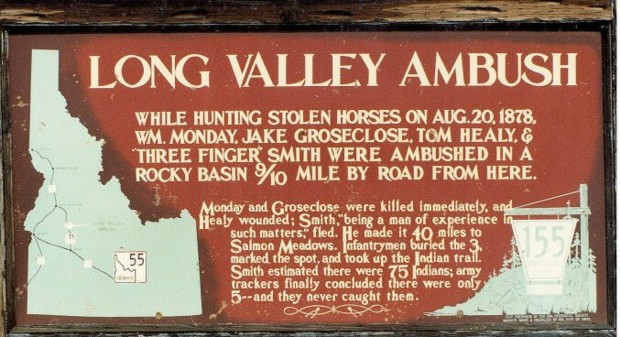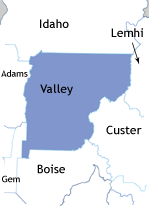Long Valley Ambush

Nellie Ireton Mills, in "All Along The River" (1963), p. 269f writes:
"Long Valley came into the news with a bang when on August 20, 1878, three Indian Valley ranchers were killed by Indians above the falls on the Payette.
"Going to his pasture early on the morning of August 17, 1878, William Monday, the first settler in Indian Valley - over the divide (to the west) from Long Valley - found that his beautiful team of matched mares had been stolen.
"Indians! There was no doubt. Moccasin and pony tracks mingled with those of the mares in the dust at gate, confirming his fears. Investigations revealed that neighboring farmers had also lost horses that night, but Monday's were the most valuable.
"William (Billy) Monday was a determined man who had overcome much. Life had dealt him many a hard blow. He was abandoned by his parents, and found, weak and hungry, in a log cabin in southern Ohio. He was not old enough to talk and give his name, so was called "Monday" for the day on which he was found.
"His wife begged him not go after them, as did his friends and neighbors, some of whom - Solon Hall, his son Edgar and Jake Grosclose - had followed the tracks far enough to determine that the Indians had gone east toward Long Valley and could make their escape. Advising against the trip also was Sylvester Smith, a mountain man wise in the ways of Indians, Tom Healy, a squaw man, also wise in Indian ways. However, Monday was determined to go.
"Early the next morning, Tuesday, August 19, Smith, Healy, Monday and Jake Grosclose, all heavily armed, took the Packer John trail for Long Valley. They reached the Payette above the falls Tuesday noon, and crossed the river to a place where the Indians were lying in wait for them along the trail.
"Ezekiel Sweet of Lower Squaw Creek (now Gem County) wrote an account of the encounter with the Indians, in which three of the men lost their lives, as follows (from Idaho Statesman):
"'In coming up the hill probably a quarter of a mile from the river the trail makes a turn to the north and runs up some heavy granite rocks some 20 feet above the trail. There are large cracks in the rock at this point, and the Indians had cut small pine brushes and stuck them in the crevices, shooting from behind them. Monday being in the lead three bullets struck him over the heart. You could cover all three with the palm of your hand. Healy crawled behind the rock and when he was found, there were thirteen empty shells around him. It always looked funny to me that these men, as well versed in Indians as they were, should have walked into a death trap.'
"Grosclose was also killed instantly. Healy called to Smith to take refuge behind the rock with him, but Smith, already shot, whirled his mule and started back down the trail. He fell off and rolled down the bank and hid in some wild rose bushes close to the river. There he is said to have found a beaver house and crawled in . . ."
Duane Petersen, "Valley County/The Way it Was" continues the story (p.13):
"He (Smith) stayed hidden for a couple of days before hiking toward Payette Lakes which was 26 miles away. He met up with the mail carrier who took him on to Meadows Valley where he could get some medical help.
"Word was sent to a U.S. cavalry unit under the command of Major Drum who were camped about 13 miles down the Little Weiser River from Meadows. When the soldiers arrived at Cascade Falls they buried the bodies of the men and marked the graves. They followed the trail to the east and found two miners killed at the Pearsol diggings (Dan Crooks and Bob Wilhelm) and also buried them. They then followed the trail into what is now called Scott Valley and turned south following the creek. They found a lone Indian boy guarding the horses. When the boy saw they soldiers he took off on his horse to warn the Indian camp near by. The Indians scattered and the soldiers recovered the horses plus others the Indians had. This is where we get the name Horsethief Basin. The area today is the site of the Idaho Fish and Game Horsethief Reservoir, a very popular fishing and camping area.
"The graves were along the river. When the first railroad tracks were built up the valley the graves were just above the tracks. Later on when Cascade Dam was built the railroad's new grade came close to covering up the site so a rock retaining wall was built to protect it. The old railroad grade has been changed into a road by Valley County and grave site is below the road. Above the road is a flag pole and plaque telling the history and names of the pioneers buried here. You have to hike up the hill just a little ways to see the flag pole and plaque mounted on a big boulder."
Sources
Mills, Nellie Ireton. -- All Along the River/Territorial and Pioneer Days on the Payette. Privately printed for Payette Radio Limited, 1963.
Petersen, Duane L. -- Valley County, the Way it Was. D & D Books, Cascade, Idaho. 2002.
 |

|
 |
Copyright © 2009 - Sharon McConnel. All Rights Reserved.
